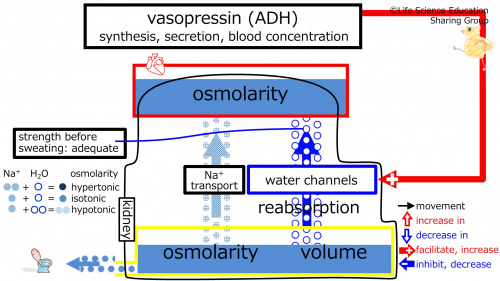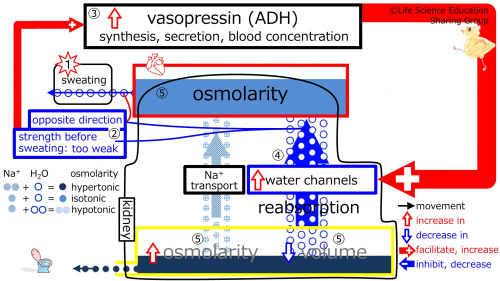「Endocrinology/VasopressinADH/ControlToSweating」の版間の差分
(ページの作成:「{{Point|With sweating, the plasma osmolarity increases, and negative feedback increases the synthesis, secretion, and blood concentration of vasopressin (anti-diuretic hormone, ADH).}} narrated video explanation <div class="avoid-page-break"> left|500px <!-- video before sweating<br> --> Before sweating (at baseline), we will make the…」) |
編集の要約なし |
||
| 8行目: | 8行目: | ||
[[メディア:ADHbeforeSweating-Eng.mp4|video before sweating]]<br> | [[メディア:ADHbeforeSweating-Eng.mp4|video before sweating]]<br> | ||
--> | --> | ||
Before sweating ( | Before sweating, 3 columns (illustraton) of water reabsorption (water entering the plasma through the water channels, which are increased by vasopressin, ADH) as well as 3 columns of Na<sup>+</sup> reabsorption (through the Na<sup>+</sup> pump) are taking place. Plama and urine osmotic pressure are normal (isotonic). | ||
<br style="clear:both;" /> | <br style="clear:both;" /> | ||
</div> | </div> | ||
2024年2月8日 (木) 21:41時点における版
| With sweating, the plasma osmolarity increases, and negative feedback increases the synthesis, secretion, and blood concentration of vasopressin (anti-diuretic hormone, ADH). |
Before sweating, 3 columns (illustraton) of water reabsorption (water entering the plasma through the water channels, which are increased by vasopressin, ADH) as well as 3 columns of Na+ reabsorption (through the Na+ pump) are taking place. Plama and urine osmotic pressure are normal (isotonic).
Step 1: With sweating, water leaves the plasma and osmolarity increases (concentrated, hypertonic).
Step 2: This is in the opposite direction to the plasma osmolarity-decreasing effect of the reabsorption (through the water channels, which are increased by vasopressin, ADH). Thus, although the strength of the plasma osmolarity-decreasing effect of reabsorption (through the water channels, which are increased by vasopressin, ADH) was adequate before sweating (at baseline), this strength is now too weak (blue) to reverse the increased plasma osmolarity (concentrated, hypertonic) produced by sweating. Control by negative feedback is needed.
Step 3: With the strength of the plasma osmolarity-decreasing effect of the water reabsorption (through the water channels, which are increased by vasopressin, ADH) before sweating (at baseline) being too weak (blue), the negative feedback increases (red) (the synthesis, secretion, and blood concentration of) vasopressin (ADH).
Step 4: The water channel-increasing effect of vasopressin (ADH) becomes stronger, which increases the number of water channels. This increases the water reabsorption from the tubule.
Step 5: With the increase in water reabsorption, diluted (hypotonic) solution enters the plasma. This will lead to a reverse in the increased plasma osmolarity (concentrated, hypertonic) produced by sweating, decreasing it towards normal (baseline, isotonic) osmolarity. Because diluted (hypotonic) solution leaves the tubule due to reabsorption, the fluid remaining in the tubule has increased osmolarity (concentrated, hypertonic). Also, with the increase in water reabsorption, there is less water remaining in the tubule. Overall, the urine becomes concentrated and decreases in volume.
Challenge Quiz
With sweating, the plasma osmolarity increases, and negative feedback increases decreases the synthesis, secretion, and blood concentration of vasopressin (anti-diuretic hormone, ADH).
With sweating, the plasma osmolarity increases decreases . This is in the same direction as opposite direction to the plasma osmolarity-increasing osmolarity-decreasing effect of the water reabsorption from the tubule (through the water channels, which are increased by vasopressin, ADH). The negative feedback increases decreases (the synthesis, secretion, and blood concentration of) vasopressin (ADH). This will increase decrease plasma osmolarity (returning to isotonic).
With sweating, water enters leaves the plasma and osmolarity increases decreases .This is in the same direction as opposite direction to the plasma osmolarity-decreasing effect of the water reabsorption (through the water channels, which are increased by vasopressin, ADH). Thus, although the strength of the plasma osmolarity-decreasing effect of water reabsorption (through the water channels, which are increased by vasopressin, ADH) was too weak adequate too strong before sweating (at baseline), this strength is now too strong adequate too weak to reverse the increased decreased plasma osmolarity produced by sweating. The negative feedback increases decreases (the synthesis, secretion, and blood concentration of) vasopressin (ADH). The water channel-increasing effect of vasopressin (ADH) becomes stronger weaker , which increases decreases the number of water channels. With the increase decrease in water reabsorption from the tubule, concentrated diluted solution enters the plasma. This will lead to a reverse in increased decreased plasma osmolarity from sweating, increasing decreasing it towards separate from normal (baseline) osmolarity. Because concentrated diluted solution leaves the tubule due to reabsorption, the fluid remaining in the tubule has an increased a decreased osmolarity. Also, with the increase decrease in water reabsorption, there is more less water remaining in the tubule. Overall, the urine becomes concentrated diluted and increases decreases in volume.




